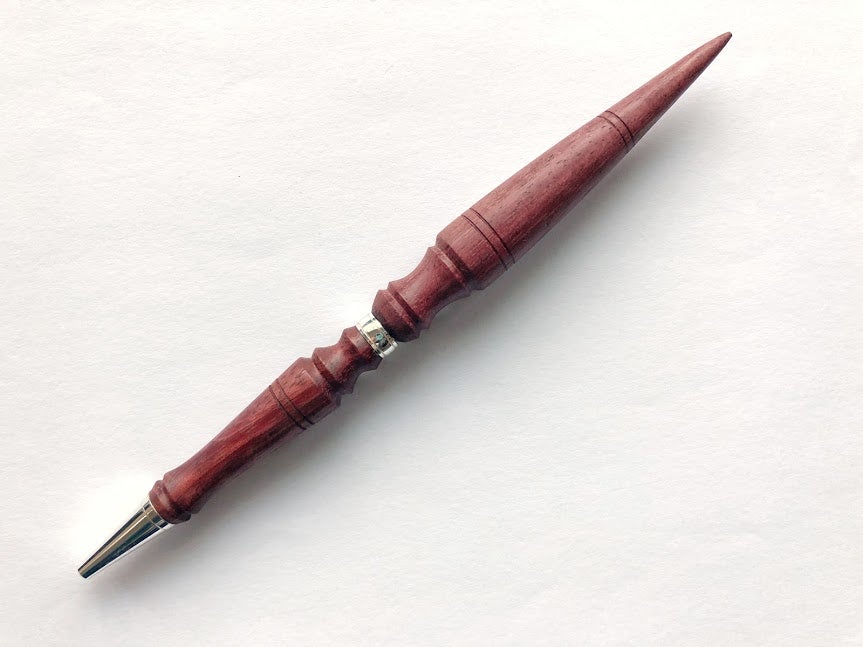Wand-erful Wooden Pens
by watchmeflyy in Workshop > Woodworking
16943 Views, 129 Favorites, 0 Comments
Wand-erful Wooden Pens





Why choose between a pen and a wand as your weapon of choice, when you can have both?

I started woodturning (cutting wood that's spinning on a lathe) recently and have been having a blast making pens and wands. I had a thought to combine the two into one concept, as inspired by this reddit post I came across, and this was the result. I learned a lot from trial and error, and the mistakes paid off as my pens got better and better. In fact, this tutorial features many types of wood in the pictures, as I took pictures throughout my whole learning process to string this guide together.
Side note: if you like this tutorial, votes in the Woodworking Contest are appreciated :)
Materials
I don't have my own woodturning studio, unfortunately, but I do get to woodturn at a shop called Lower 48! It's a nonprofit in California for woodturning, and where I myself learned.
- wood lathe (I used a small Nova Comet II)
- pen blanks (Usually come in 3/4" x 3/4" x 5" blocks. Good source for nice blanks is Penn State Ind [subscribe to email for % off, watch inbox for occasional 20% off offers], Woodcraft [subscribe to email for % off, occasional product discounts], or even eBay)
- wood turning gouges (I used a roughing gouge, spindle gouge, and scraper)
- live center for tailstock
- center finder, awl, and hammer
- drill press
- thick (gel) super glue
- 7mm pen mandrel
- slimline pen kit
- 7mm drill bit
- 7mm barrel trimmer
- slimline pen bushings
- sandpaper (I use 120, 240, 320, 400 grits) and paper towels
- finishing wax and oils (explained further in step 10; I use any of boiled linseed oil, tung oil, or Boos mystery oil with wax sticks)
- Jacobs chuck + barrel trimmer OR scrap chunk of pen blank and spur drive center (explained further in steps 6 and 7)
Prepping Blanks
For this pen, you'll need two pieces of wood: one that's about 2-1/16" long (the same length as the 7mm brass tubes in the slimline kit, + 1/16" for barrel trimming later) and another that's as long as you like (for the tip of the wand-pen). I just used two standard 3/4" x 3/4" x 5" pen blanks: cut off 2-1/16" of one using a miter saw and used the full 5" of the other for the top section.

You'll need to drill holes into each of them, and for that you'll want the holes as centered as possible. Use a center finder to locate the center on one end of the blank and use the awl and hammer to make a guide hole at that location.

If you don't have a center finder, use your best judgment and make a guide hole with the awl at that location.

Drilling Blanks
Drill 7mm diameter holes through the blanks for the brass tubes of the slimline kit to fit, using the guide holes from the previous step. The holes should be as perpendicular as possible so you get the hole going through the whole blank and not at an angle. For this, it's handy to have a jig attached to a vice: there are diagonal cuts that basically help hold the wood upright as you drill into it (image below). You can still use any old clamp, but this system is very helpful for drilling holes in blanks.

For drilling into the wood, you'll want to do "peck" drilling to avoid it cracking from pressure and chip buildup. Cut into the blank 1/4" deep at a time, pecking into the wood and raising the drill bit to clear chips. If you have issues with the wood cracking, it may be because you are drilling too quickly or not clearing the chips often enough. It can also be helpful to have a flat piece of scrap wood supporting the bottom surface of your blank as you drill through the bottom.

Drill a hole through the 2-1/16" section first. It should go all the way through. Then, for the longer blank, you still only need to drill 2-1/16" deep, not through the whole thing, in order to glue the brass tube. To do this, use your drill hardstops on the left of your drill press. With the drill bit tip resting on the top of your long blank, put the 2-1/16" blank at your hardstops and adjust the top one so that it rests at the top of the blank, as shown below.

If you happen to be drilling with a handheld drill (brave of you!), you can tape your drill bit at 2-1/16" from the tip and drill to the tape edge.
Use your barrel trimmer to clear out the hole you made in the long blank (chips may be stuck at the bottom, and it may be a bit ragged), and drop a brass tube in to make sure the hole is deep enough. If not, gently twist the barrel trimmer in the hole to make it deep enough, or go back to drill press as necessary.

Gluing Brass Tubes and Squaring Ends
The brass tubes can now be glued inside the holes you just drilled. Use an epoxy or thick gel super glue, not the thin kind: there is a gap between the tubes and the wood, which you'll want a thicker glue to fill up.

Wait a generous amount of time for the glue to dry. Sure, the instructions will probably say that it sets in 10 seconds or so, but you don't want to risk wasting your precious wood or worse, having the wood fly off the tube and at your face.
Once the glue is sufficiently dry, the blanks will need to be squared, meaning that you need to make sure the faces at the end of the brass tube are as close to perpendicular to the tubes as possible. That ensures that the pen hardware will sit flush with the bottom edges when you assemble everything. Use your barrel trimmer for this. If I cut the blanks a bit too long and know it would take forever to trim by hand, I use a belt sander to get the wood close before finishing the trim by hand.

Turning on Lathe: Shorter Section
Start by turning the shorter section. It doesn't matter which section you do first, but it's easier to do the short one since it's like turning a regular slimline pen and it helps you get in the groove to do the longer section. Mount the blank (you can do two at a time, like shown below) with slimline bushings in your pen mandrel.
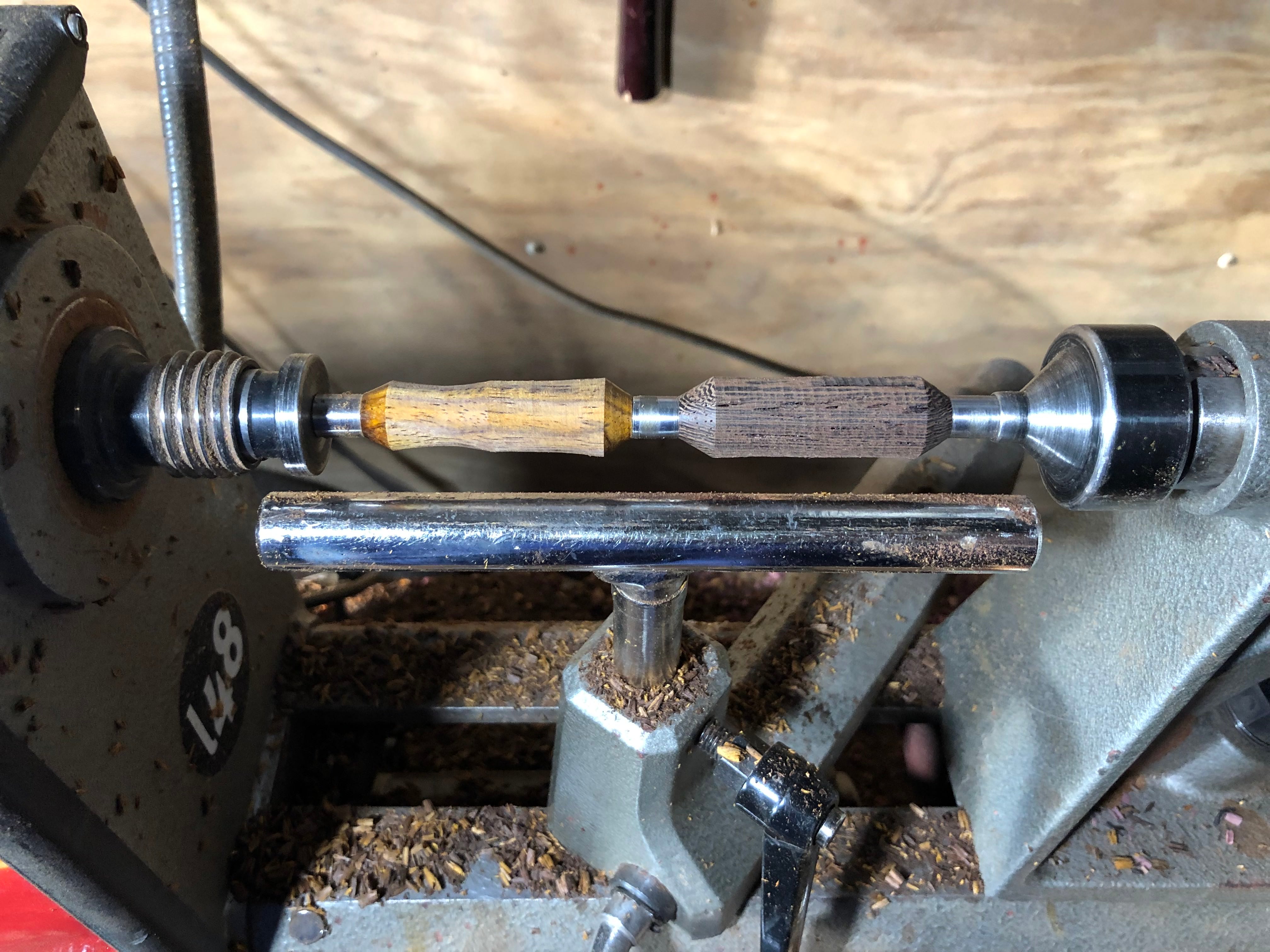
I won't go into how to use woodturning gouges, as there are much better video sources to provide guidance on that. I will point you to videos that I found helpful though: this one is a great breakdown of how to use the basic set of gouges, and this one is great for understanding wood catches, demonstrating what a "wrong" cut looks and sounds like. For general good technique and inspiration, Carl Jacobson has great videos, along with Alan Stratton from As Wood Turns. When turning pens, I usually just stick with a roughing gouge for cutting off the square corners, then a scraper for making smooth curves along the blank, and spindle gouge for tapering the ends and creating beads/coves/designs.
Don't forget to sharpen your tools, especially when turning hard, brittle woods like ebony, palms, and wenge! It's never a bad thing to sharpen: if you're wondering if you should sharpen, you probably should've sharpened 30 seconds ago. I usually sharpen all my tools every two blanks I shape. For palms and harder woods, I also turn up the speed to reduce tearout. Also, remember not to go too thin or over-tighten the tailstock, unless you want to waste your precious wood:

Mounting on Lathe: Longer Section
To turn the longer section, you'll need to support both the end with a brass tube in it and the end without. For the brass tube, we'll use a barrel trimmer stuck into a Jacob's chuck. (see next step for an alternative method though) That way, you can also slip on the slimline bushings to make sure you're tapering the edge to the right diameter to fit with the pen hardware. The metal is a nice and rigid surface, not to mention that this open end "chuck" is easy to assemble with things you might already have lying around. On the other end at the tailstock, you'll have a live center.

Slip the brass tube end of the blank onto the barrel trimmer and bring your tailstock up to the other end to make a small indent on the bottom of the blank. Take the tube off and use an awl to make a deeper indent at that location, so that your live center has more of a surface to catch onto. Then mount the blank back on your lathe, and tighten it between the chuck and live center.

Alternative Chuck
If you don't have a Jacobs chuck, spare barrel trimmer, or don't want to go through what was described in the previous step, an alternative way is to make your own jam chuck.
I have lots of 3/4" x 3/4" x 2" cutoffs of ebony due to the longer length that my ebony pen blanks come in, and I used one to make a jam chuck. This is initially how I made all these pens, but I had issues with concentricity since the wood could still spin off axis easily. It's especially because I was turning between two centers; I now know that it would've been better if my jam chuck would've been big enough to at least be clamped in a jaw chuck on one end...
In any case, for a jam chuck you want to narrow down one end to be an end you can shove into the hole of the brass tube in the long section of the pen. That means you should taper down to a 7mm diameter, which you can use calipers to check with.

Once you're happy with the diameter, continue cutting in with a spindle gouge or parting gouge until you get to a diameter you can snap with your fingers.

Again, I highly recommend you start with a piece of wood that you can turn to fit in a chuck rather than turning between centers (so you'd have a chuck on one end securely holding concentricity and a live center on the other end). Below is how I set up my jam chuck between centers, though. You shove the ~7mm portion into the hole and tighten your tailstock as much as possible so that you don't knock the wood off axis.

Since you don't have bushings to control the end diameter, it's more difficult to ensure a proper fit with the slimline kit. I had to take this off the lathe to check against bushings, which isn't good for keeping concentricity.

Turning Long Section
While turning the long section, you'll want to cut slowly and not too deeply. If you cut too deeply and your tools cause the wood to shift at all, that would throw off your centricity and cause you to cut off-axis. It might look fine when you take the wood off the lathe, but it would manifest when you put the top on your slimline pen and you notice the tip isn't straight. Rough out your shape slowly, and turn up the speed as necessary to avoid catching on the wood. Be especially careful while using a spindle gouge to make deep cuts. The wood may "chatter" as you get thinner and thinner: this will cause uneven grooves in your wood from it flexing. To avoid this, go slowly and if it gets too bad, consider using a steady rest if you have access to one. This shouldn't be needed if your wood is less than ~6in long.

Below is an example of what knocking your part off-axis looks like. You can see ghostly projections around the part since the bottom section is no longer concentric with the turning axis. Since I had so much material still (still roughing out the wood), it wasn't a big deal: I could still remove material to make everything concentric again. You can imagine that if I had less wood it would be a different story: removing material would then make everything too thin to the point of snapping, not to mention increasing the chance of wood catching from the uneven cut.
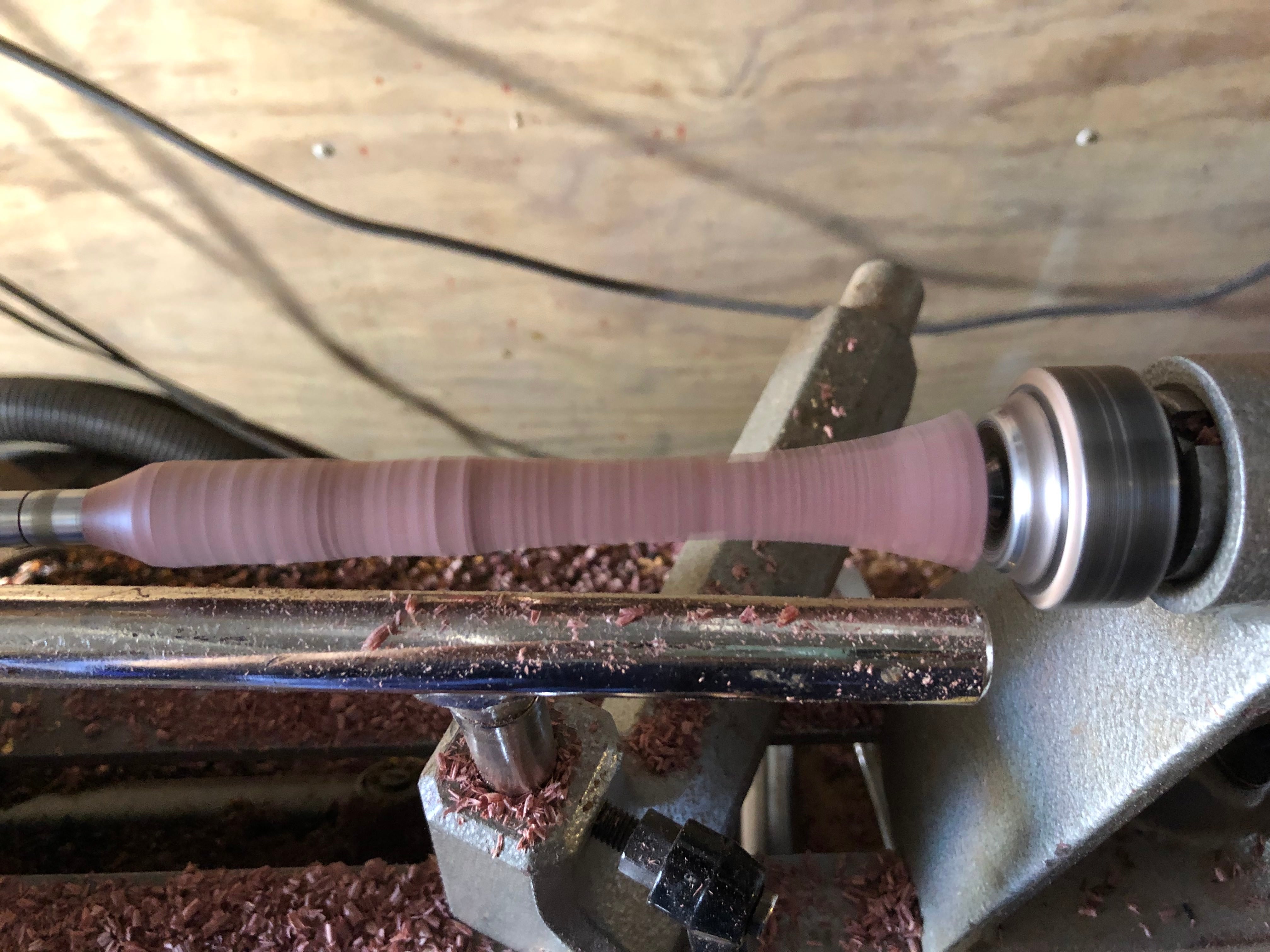
As I got the hang of things, I realized that its helpful to sand and finish while you can. Thus, even if the full shape weren't finished yet, I would stop to sand just the top portion. This is so that if anything gets knocked off axis later or the wood snaps off, I could at least have intricate details sanded nicely. If I need to sand on a drill press (described later in step 14), I would not be able to reach into crevices and get as nice a finish. Below, you can see that the top portion is decently sanded even though the part isn't finished. Note that the end is still thick: I like to keep the ends thick and finish them first, before going back to make any part in between narrower. This is to prevent snapping as much as possible, though it is time consuming.

Speaking of sanding, let me talk about that for a bit...
Sanding
Surprisingly, sanding is something that takes practice. The keys are knowing how long to sand for and learning where to keep sanding.

For sanding, I used 120, 240, 320, and 400 grit sandpaper. Go slowly with each grit and double check between grits to make sure you've gotten rid of all deep grooves (you'll notice distinct lines thicker than the surrounding ones, if you still need to sand). Wiping with denatured alcohol can help with that: that will make lines more distinct so you spot problem areas more easily. Make sure you don't stay in one place for too long, or you'll end up with radial cuts. To further rid radial cuts that are just inevitable, sand lightly along the axis of the lathe (so from chuck to tailstock, back and forth) between grits.

Be delicate with sanding as your piece gets thin! It's easy to sand too far and have things snap :( See below: it's delicate at the tailstock end due to the diamond shapes, so be careful there. Also, note that I sanded the diamonds before going back to taper down the portion to the left. I ended up wanting to make that portion thinner to make a smoother curve to the diamonds, but wanted to stay safe and sand the diamonds before hand in case the piece snaps off the lathe. That way, I wouldn't have a tough time sanding them on a drill press (see step 14).
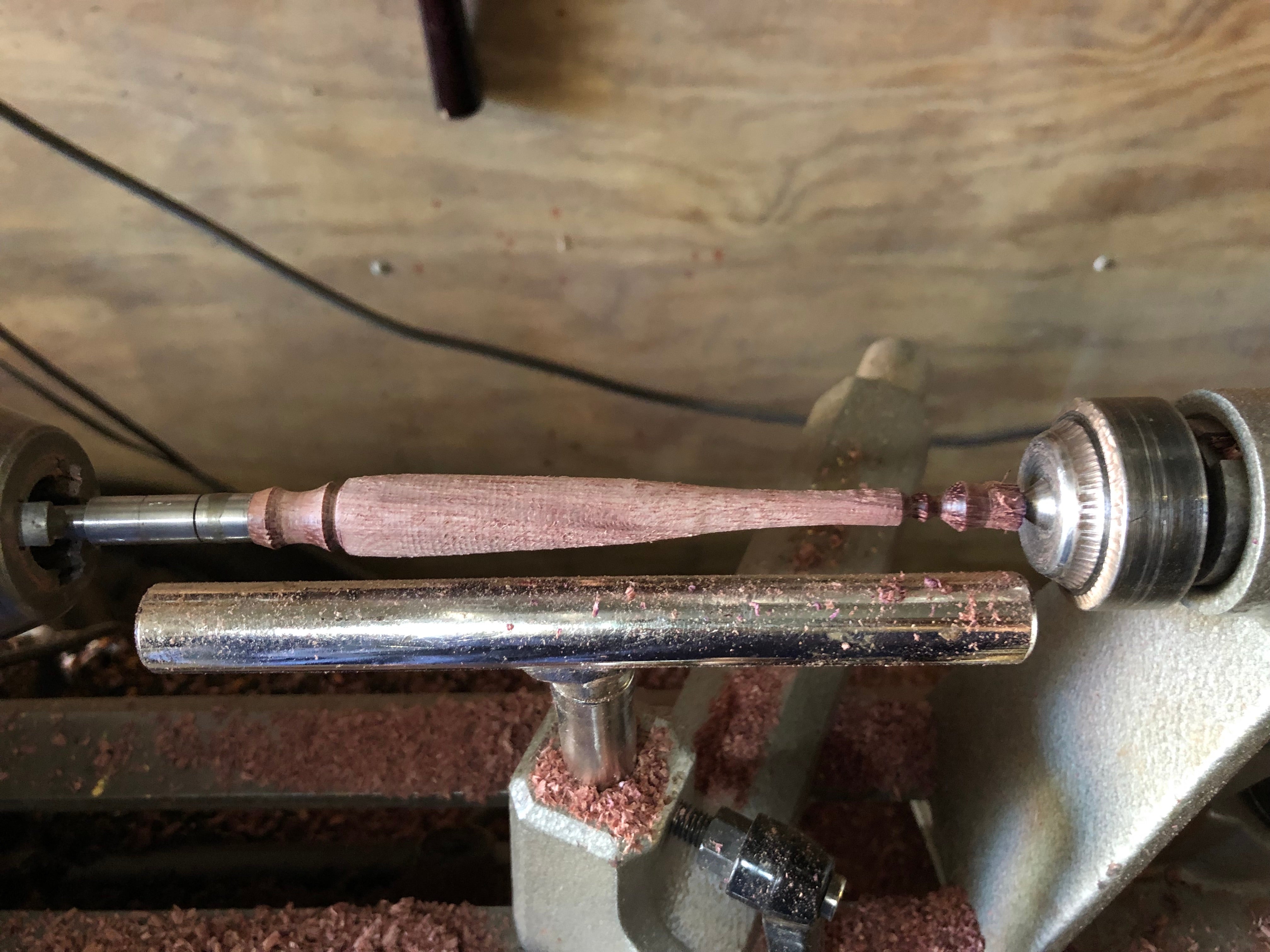
Here's another picture. Again, I kept a thick end at the tailstock and sanded everything before tapering with a spindle gouge.

Finishing
I like oil and wax finishes since I like to preserve the original, natural feel of the wood. A popular finish is CA glue, which I won't cover but you can look up as needed.
Grab a small piece of paper towel and rub in an oil, like boiled linseed oil or tung oil, into your wood. Personally I use this bottle of mystery oil that work nicely. You'll see it darken and the grain will pop!
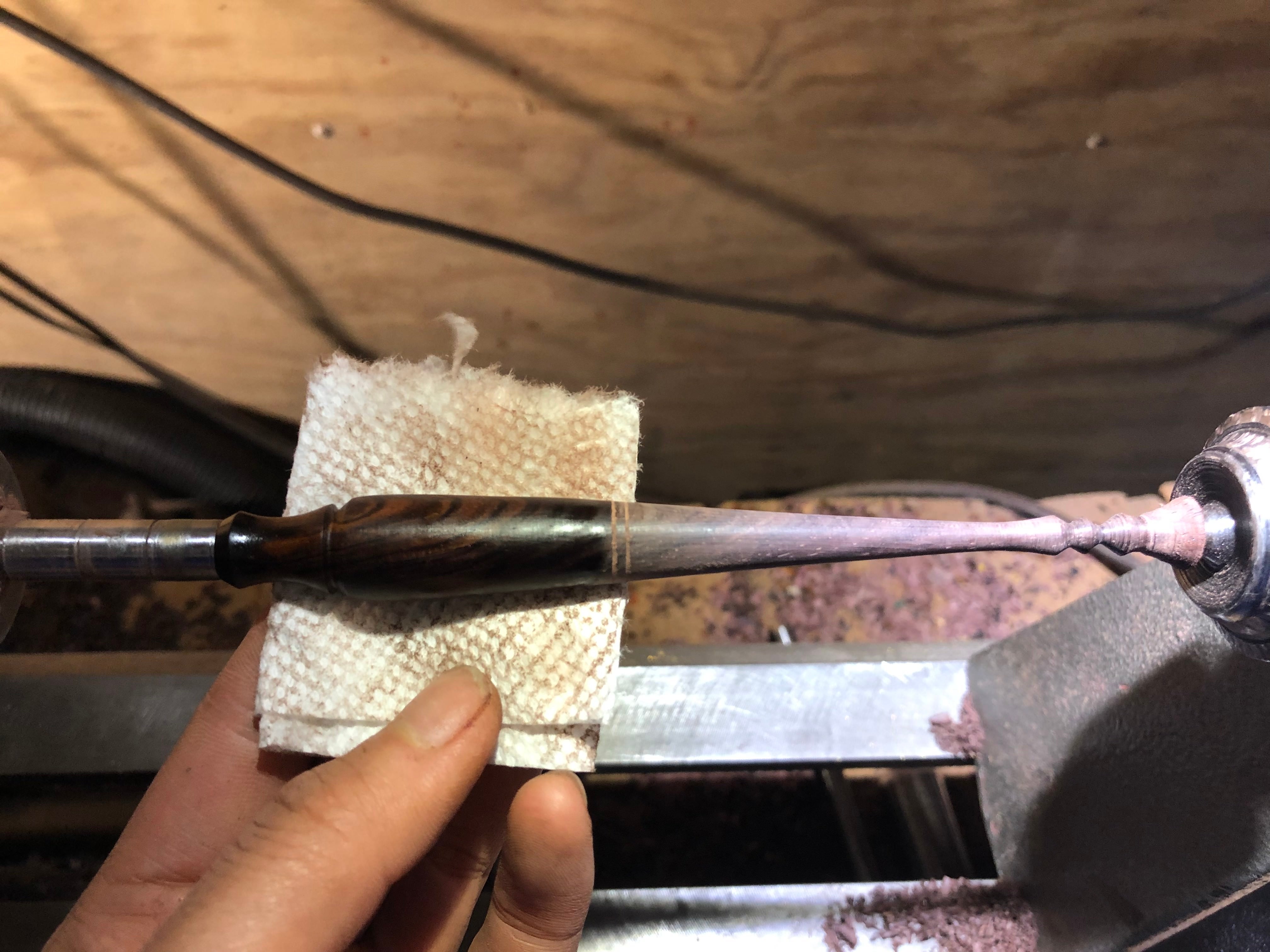
I like to use an abrasive-imbedded wax like hut wax to further polish the wood and protect it. Unfortunately, I misplaced the stick of it so I use a stick of abrasive polish (red) and a bar of carnauba wax (yellow).

To use these, lightly run the stick across your piece while it's spinning on the lathe (yes, this means your piece should still be mounted on a lathe). You'll see spirals if you're going the right speed. You don't want to cover the piece; you just want a bit to rub into the wood. Next grab your oily paper towel, turn up the lathe speed, and rub the compound into the wood. You'll want high enough pressure that you feel heat building up under your fingers, but not enough that you start scorching the wood (surprisingly easy!).

Do the same thing with the carnauba wax (remember to turn the lathe speed back down for running the wax stick against the wood), and then you're finished!

Wax Rubbing to Add Color
I have a texturing tool to make interesting shapes in the wood. This makes crevices that I can put color into. To do this, I mix gold powder (left below) with a soft wax (right) to form a paste that I rub into the cracks and all over the wood. This looks especially good with brittle woods that have tear out or lots of pores in general, such as palms and wenge. It looks great with ebony too, since the metallic powder contrasts nicely with black.

I've generally had luck with just rubbing the wax in and wiping it off with a paper towel (use oil if it's tough to rub off). Then I just let it dry, and it doesn't come out of the grooves unless I really dig for it.

I think spraying a clear finish would help protect it more though. I have tried a CA finish with... mixed results. I don't like CA as a finish just due to the hassle and smell but it also turned the wax a little cloudy. Not too noticeable though.
Assembly

To finish, remove the piece from the lathe. You can do this by going in with your spindle gouge gradually at the tip and narrowing the diameter until the piece snaps off the lathe. Then sand the tip by hand, and add oil. Alternatively, if I feel like the tip is too risky, I'll just remove it from the lathe and sand the tip down to a taper by hand with a sanding wheel. It's difficult to get right, for me at least, but practice makes perfect!

To assemble, press the pen tip to the bottom of your shorter section. Then press the main pen hardware (that houses the pen) into the opposite end of the shorter section. Slip the middle band on, insert and screw in your cross-style ballpoint refill, and push the long section on top. Voila!
I'll take a chance to showcase some of the wand-erful pens I've made so far. The one below is purpleheart wood with chrome hardware.

Below is ebony with golden hardware and gold paste rubbed in.

This one is wenge with the same gold hardware and gold paste. I learned to use the pores to my advantage!

For the next steps, I'll go over things that have gone wrong for me while making these, and how to avoid them.
Mistake #1: Wrong End Diameter
Before I had the chuck method in which I could string on bushings to help meet the diameter for slimline pens (i.e. my jam chuck method), I had to just eyeball the diameter. Sometimes, taking the part off and on the lathe messed up my concentricity and I got lopsided diameters at the end. In the picture below, you can see how the hole is off centered, significantly. :(

In the picture below, you can see what you should've gotten, had you maintained concentricity.

It's much easier to get this when you use the Jacob's chuck method I described, or at least hold the jam chuck in a chuck instead of between centers. To at least make the lopsided version look more normal, you can sand perpendicular to the tube to shorten the length but get a thicker diameter at the end. Then taper down the end more naturally by spinning the tube by hand at an angle against a belt sander. More difficult but that's the only way, short of managing to remount on the lathe.
Mistake #2: Tapering Too Quickly
This is for when you're shaping into your longer section of the pen. If you cut too deeply into your wood right at where the hole for your brass tube ends, you might snap the wood since you may have drilled too deep and it was hollow with no brass support at that point.

To avoid this, keep a slimline brass tube nearby and mark that length on your wood. Then keep eyeing that region to make sure you don't cut deeper than the diameter of the slimline bushing at that area. Use calipers to measure that region as a sanity check, if you'd like more security.
Mistake #3: Unexpectedly Snapping Off the Lathe
I had issues with turning the wood too thin in the middle before shaping diamonds at the tailstock end. This caused the thin section to snap off the lathe.

I avoided this later on by shaping the tailstock end before going back to make the portion before as thin as I wanted. To at least savage the pieces that snapped, I sanded them down with my drill press.
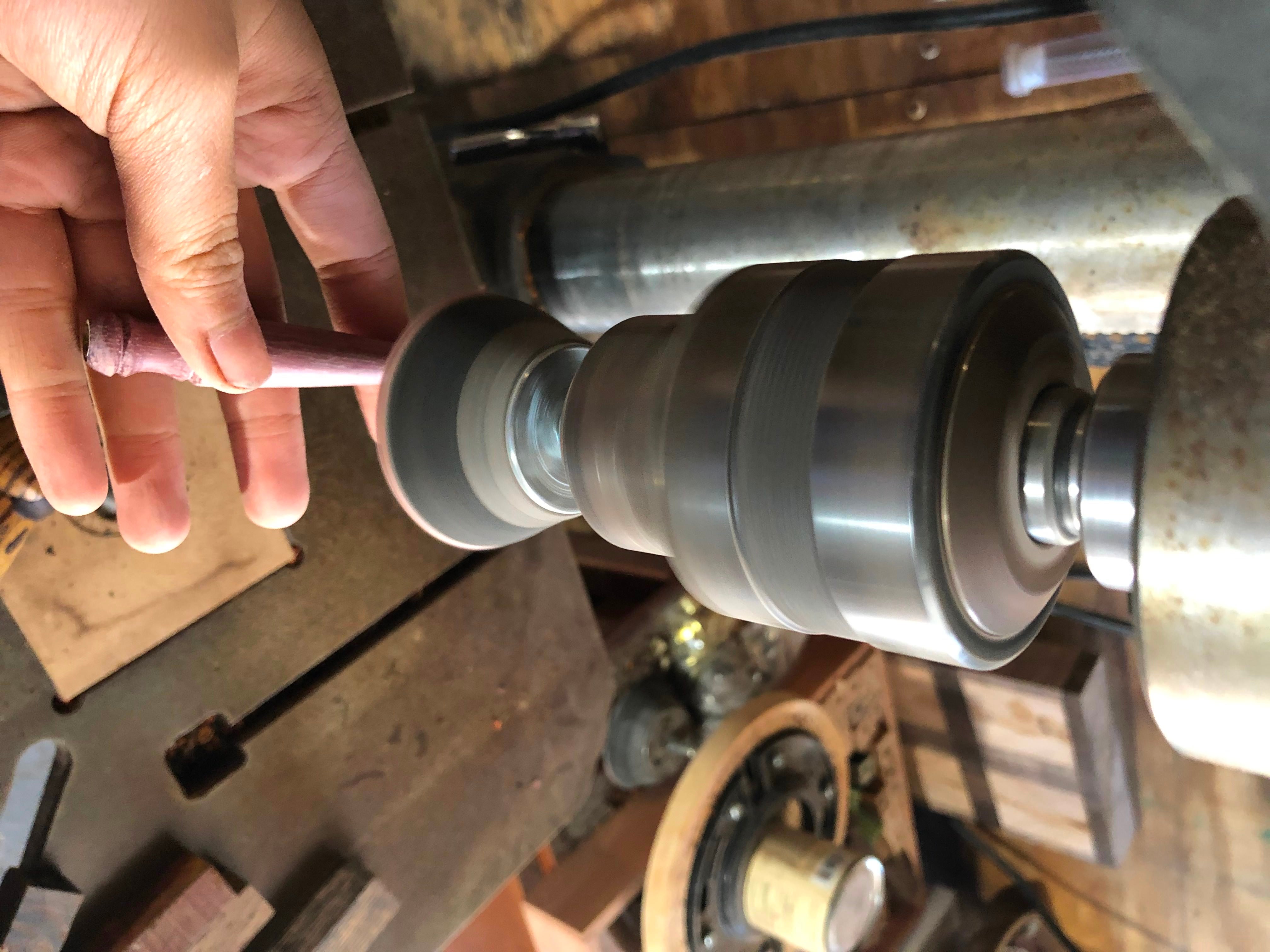
To do this, I mounted a sanding wand in the chuck and used corresponding sanding pads to smooth out the jagged end. Again I used the same grits, up to 400 grit, before wiping with oil.

Since I can't do the polish and wax finish on the lathe, I just wiped on a paste wax: Tree Wax

And here is the final picture: not as long as I would've wanted, but savaged at least.
